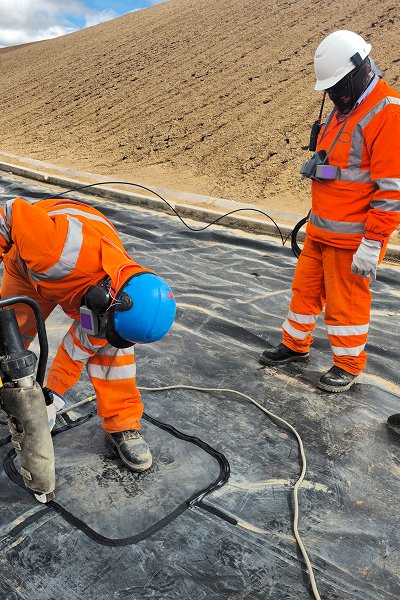What is geomembrane?
Geomembrane is a sheet-like flexible material made of high molecular polymer (such as HDPE, LDPE, EVA, PVC, etc.), which has excellent anti-seepage, chemical stability and weather resistance. Geomembrane can be divided into many types according to its material and process differences.


Key factors affecting the service life of geomembranes
Resin type and quality: HDPE membrane is made of high-quality polyethylene resin, with high density and stable molecular structure. It is one of the longest-lived membrane types;
Thickness: The thicker the membrane, the stronger its ability to resist puncture and aging (common thickness is 0.5mm~2.0mm);
Additives: Antioxidants, UV absorbers, carbon black, etc. can significantly extend the life of geomembranes.
Ultraviolet radiation: Long-term exposure to sunlight will accelerate polymer aging;
Temperature change: High temperature promotes material molecular movement and easily accelerates thermal oxidation aging;
Water and humidity: Continuous immersion in water or repeated dry-wet cycles will reduce the stability of the membrane structure;
Chemical corrosion: Media such as acids, alkalis, heavy metals, solvents, etc. will accelerate the degradation of the membrane;
Microbial erosion: In some environments, bacteria or fungi can decompose polymer components.
Tensile stress: stress concentration during construction, laying and backfilling may cause stress cracks in the membrane;
Puncture damage: sharp objects, roots or uneven base surfaces can cause local weakness;
Foundation settlement: uneven settlement can cause geomembrane to stretch, deform or even break.
Engineering Case Analysis
Landfill HDPE Membrane Service Life
A city landfill used 1.5mm HDPE membrane in 2005 and has been in operation for nearly 20 years. After on-site sampling and testing, its weld strength, carbon black distribution, oxidation induction time (OIT) and other parameters are still within the acceptable range, and its actual service life is expected to reach more than 50 years.

Artificial Lake LDPE Membrane Degradation Case
The artificial lake was paved with LDPE membrane (0.5mm) in 2008, but due to long-term exposure without soil protection, large-scale cracks and leakage appeared only 8 years later, and the membrane needed to be re-paved.

Technical measures to extend the life of geomembranes
Choose raw materials with high content of antioxidants and UV stabilizers;
Use black membranes with a carbon black content of 2-3%, which significantly enhances the anti-ultraviolet ability;
Choose membrane materials with a thickness of ≥1.5mm according to the importance of the project.
Soil covering: the simplest and most effective way to avoid direct ultraviolet radiation and temperature changes;
Cushion protection: set up a sand cushion or geotextile to protect the membrane body;
Stress buffer design: design a gentle slope and set expansion joints to relieve membrane strain;
Joint protection structure: such as double membrane + leakage monitoring system, composite lining system, etc.
Strictly control welding parameters: temperature, pressure, speed, etc.;
Set up weld inspection procedures: vacuum test, airtightness test, etc.;
Avoid construction injuries such as wrinkles, pulling, and hard object puncture.
Regularly check whether the surface is bulging or cracked;
For long-term exposed areas, apply anti-aging coating;
Establish a leakage monitoring system to grasp the status of the anti-seepage layer in real time.


